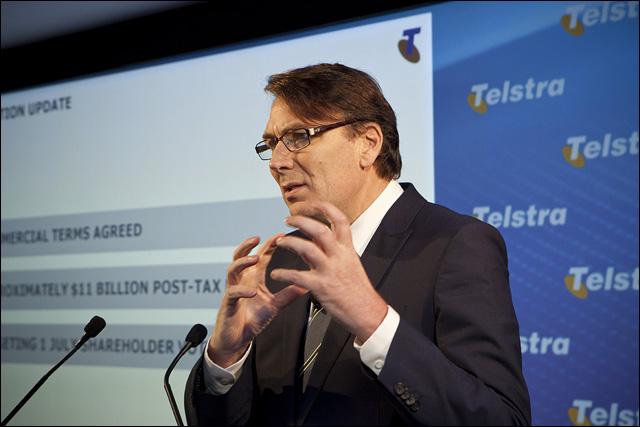The nation’s largest telco Telstra today started throwing its sizable weight around in Australia’s burgeoning cloud computing market, throwing down a $800 million investment in the space and revealing a tranche of new corporate customers.
At a press briefing in Sydney this morning, the company revealed that winemaker Australian Vintage, The Salvation Army’s Employment Plus division, Oz Minerals and Tristar Medical Group had signed up primarily for Telstra’s infrastructure as a service offering, with some using other hosted offerings such as Microsoft’s Business Productivity Online Suite, which has been re-badged as Telstra T-Suite in Australia. The company already boasts names such as Tabcorp and heavy vehicle manufacturer Kohmatsu on its cloud customer roster.
In an associated statement, Telstra chief executive David Thodey said sales of Telstra’s T-Suite platform had grown threefold over the past year, while use of its infrastructure as a service platform had grown by nearly 50 percent this year.
“We are also experiencing strong sales in our cloud voice and video services, which are exceeding 80 percent per year, and we now manage more than 100,000 IP telephony services delivered from the cloud,” Thodey said. Telstra has spoken to more than 160 Australian organisations over the past 12 months about their cloud computing needs.
The $800 million spend will go on a range of areas over the next five years, but will especially be focused on the construction of a new Melbourne datacentre, slated to go live in 2013, which will bolster Telstra’s hosting capability by more than 40 percent, with an extra 2000 square metres of space. The company will need the extra capability – with it seeing a 100 percent increase in demand for its datacentre hosting facilities in recent times.
The money will also go on modernising existing Telstra datacentres, expanding the range of enterprise applications the company provides, building a new integrated online account management portal, increasing the automation of utility computing services, and enhancing the capabilities of T-Suite. The company’s key partners for the next phase of its strategy will be Cisco on the hardware front, VMware for virtualization, Accenture for the company’s systems integration skills and Microsoft for software.
In one of his first public appearances since his appointment in January, Telstra chief operating officer Brendan Riley said Telstra was seeking to build the “biggest network-integrated cloud in the country”, integrating its server and storage infrastructure with its core Next IP MPLS network. The company is planning to focus on a set of ‘certified’ applications to run on that network, although it wouldn’t confirm what those would be at this stage.
Telstra’s main rivals on the enterprise cloud computing front are companies like Optus, Fujitsu, CSC and HP, which are fast building their own cloud infrastructure hosted in Australia, including features such as dynamic provisioning of resources and extensible infrastructures.
However, despite a rash of cloud product launches over the past year, none of the companies has been successful in attracting a major top-tier brand name customer such as a major bank or government department onto its cloud. The customers which Telstra has so far signed up on its network have been primarily medium-sized companies outside the ASX100.
In addition, major organisations such as Westpac have acknowledged they are building their own internal private clouds, rather than shifting workloads onto the infrastructure owned by companies such as Telstra.
Queried about the issue today, Telstra’s Thodey said he wasn’t sure that there was any kind of ‘inherent cap’ on the size of the customers which would adopt Telstra’s cloud computing solution, but noted he believed there was a sense in which Telstra would be “quite happy to take it as a step at a time”.
“One of the things which we’ve done is to take a lot of time to deploy it internally and get it right,” he said. “I don’t think the size of the customer is really the issue.”
Telstra executive director Philip Jones also responded to the question, noting that he believed that one piece of the puzzle for large customers – especially organisations in the public sector, for example – was to be able to shift virtualized workloads off their own infrastructure and into Telstra’s cloud. The executive noted Telstra was already talking to major companies about shifting workloads into cloud. “I think over time, the question is moving from size of customer to type of workload,” he said.
Image credit: Telstra


More marketing from Telstra…
BPOS…..hasn’t MS killed that with 365?
Yes, but Office 365 is still in beta, I believe.
Comments are closed.